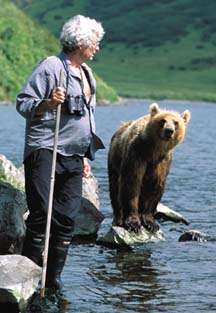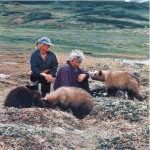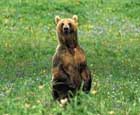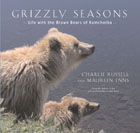|
Background Information on Kamchatka
|
||||||||

Additionally, Charlie is creating new goals and projects that are related to the grizzly bear. These items will appear on this website under a different organization.
Maureen Enns has completed this project and is moving on to some new projects and art directions.

Bears and People Can Share The Same Land!

![]() INCE the beginning of history,
one of human kind’s greatest challenges has been to bridge the gulf
that divides humans and animals. Is it possible for man to live closely
with animals - especially ones as powerful and courageous as a grizzly
when both have been conditioned to fear one another?
INCE the beginning of history,
one of human kind’s greatest challenges has been to bridge the gulf
that divides humans and animals. Is it possible for man to live closely
with animals - especially ones as powerful and courageous as a grizzly
when both have been conditioned to fear one another?
Naturalists, Charlie Russell and Maureen Enns are undertaking this very
important challenge through their project -- the Kamchatka Grizzlies of
the Far East. This study is about testing theories that could allow for
people to share habitat with this animal in ways that are safe and sustainable
and also suggests ways to enjoy these large predators.
The study area for this project is situated at Kambalnoe Lake at the southern
tip of the Kamchatka Peninsula in the Russian Far East. This is one of
the last great wilderness areas left in the world and provides an ideal
environment for this study because the bears in that area have little
or no contact with human beings other than those who are studying them.
This project began by locating the ideal site and constructing a cabin
at the foot of the Kambalnoe Volcano which became their base camp. In
1997, Charlie and Maureen raised 3 orphaned grizzly cubs (Chico, Biscuit
and Rosie) and reintroduced them to the wild. They have returned each
summer since then to continue their relationships with these cubs who
have become the central participants to their study of human coexistence
with bears. They are now 5 years old and about 450 pounds.
The study in Kamchatka, Russia will enter its 8th year in 2003. Many of
our research goals are now being achieved. We have proven it is possible
to peacefully co-exist with grizzly bears as close neighbors. Now our
efforts to consider the legacy for our work, by conserving in perpetuity
the Southern tip of Kamchatka begins. We are excited that our first book,
Grizzly Heart, written by Charlie, has been published
internationally and in five languages. Our book of photography Grizzly
Seasons will be release September 23, 2003.
We wish to extend an official and heart-felt thank you to all of our sponors
for the generous contributions to our research on Grizzly bear/human co-existence.
To view more of the website please click on the topics, diary entries or publication sections. The latest information is in the 2003 diary entries.
Topics
Charlie & Maureen's Cabin

Diary Entries

Biscuit at 5 1/2 years old.
Publications/Video
Grizzly
Seasons
Grizzly
Heart
Spirit
Bear
Grizzly
Kingdom
Walking
With Giants
Copyright 1997 – , all rights reserved, Pacific Rim Grizzly Bears Co-Existence Study of Charlie Russell and SKR Design LLC.
